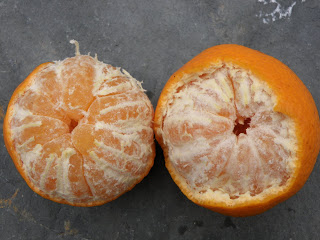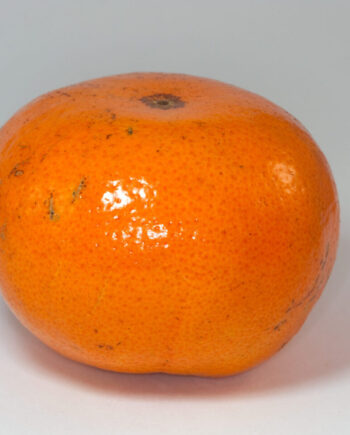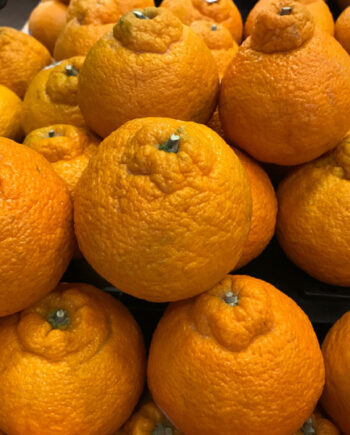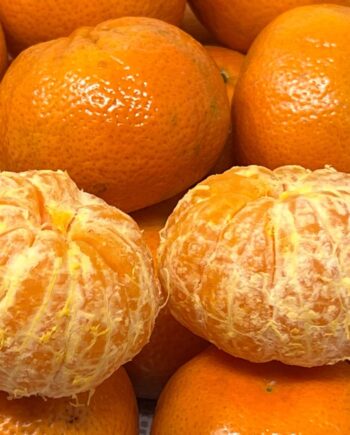Mandarin Trees
Showing all 4 results
-
Dancy Mandarin Tree
Citrus reticulata 'Dancy' Dancy mandarin trees produce fruits with sweet and tangy flesh that is very delicious. This variety has seeds and easy-to-peel skin. Mandarin trees have fragrant white flower blossoms in late Spring and fruits ripen in the...Select options This product has multiple variants. The options may be chosen on the product page -
Honey Mandarin Tree
Citrus x reticulata 'California Honey' The Honey Mandarin tree produces sweet, seedless, and easy to peel fruit. They have thin skin that is red-orange in color. Also sold as tangerines, the fruit can become medium to large in size. The tree produces fragrant, ...Select options This product has multiple variants. The options may be chosen on the product page -
Satsuma Mandarin Tree Owari
Citrus unshiu The Satsuma Mandarin tree produces sweet and juicy fruit with puffy, very easy to peel skin. Considered to be an ugly looking fruit with an unusual shape. It has a very delicious flavor and is a moderately sized tree that ...Select options This product has multiple variants. The options may be chosen on the product page -
Tango Mandarin Tree
Tango mandarin is sweet, tangy, seedless, and easy to peel. Tango mandarin is a very delicious, juicy, and very popular variety grown by the largest farmers in California.Select options This product has multiple variants. The options may be chosen on the product page
Mandarin Trees
Mandarin trees for sale in Los Angeles, California are relatively difficult to find due to the strict regulations required of nurseries. However, we at Paradise Nursery follow all requirements to continue to be a great source of mandarin fruit trees.
The mandarin tree (Citrus reticulata) is a small, evergreen tree native to Asia. They’re known for producing sweet and easy-to-peel fruits called mandarins or tangerines. These fruits are a popular citrus variety and are enjoyed around the world for their juicy, flavorful flesh.
Here are some key characteristics and information about mandarin trees:
- Appearance: Mandarin trees typically have dark green, glossy leaves. The fruit is generally small and round, with a thin, loose peel that is easy to remove.
- Varieties: There are several different varieties of mandarin oranges, including Clementines, Satsumas, and Tangelos, each with its own unique flavor profile and appearance.
- Growing Conditions:
- Climate: Mandarin trees thrive in subtropical to tropical climates. They prefer warm, humid conditions but can also tolerate some cold weather, depending on the variety.
- Soil: Well-draining soil is crucial for healthy mandarin tree growth. They prefer slightly acidic to neutral soil pH levels.
- Propagation: All our Mandarin trees are grafted.
- Care and Maintenance:
- Watering: Water regularly, especially during dry periods. However, do not let water stand, so well-drained soil is important.
- Fertilizing: Mandarin trees benefit from balanced fertilizers that contain essential nutrients like nitrogen, phosphorus, and potassium.
- Pruning: Prune to help maintain the shape of the tree and improve air circulation, which is important for preventing diseases.
- Harvesting: Mandarins are typically ready for harvest in the late fall and winter months, depending on the variety and climate. They should be picked when they are fully colored and have a slightly loose peel.
- Common Uses: Eat Mandarin oranges fresh. However, also eat in salads, desserts, and as a flavoring in various dishes and beverages. They are rich in vitamin C and other essential nutrients.
- Cultural Significance: Mandarins hold cultural significance in many parts of the world. Particularly in Chinese culture where they are associated with good luck and prosperity, especially during the Chinese New Year.
Plant Care Information
Watering Basics
Irrigation Management Basics
Water Frequency – The frequency of water depends on seasonal weather conditions such as temperature, wind speed, and humidity, as well as factors like soil type and plant health. Sandy soils dry faster than clay soils.
In General
- Water newly planted trees 2 times per week during the Spring and Fall seasons.
- Increase the frequency when temperatures increase during the Summer
- Reduce frequency once temperatures drop in Winters
Quantity of Water – Provide enough water to saturate the soil around the tree’s roots, then drain to field capacity. Clay soils hold more water than sandy soils.
In General
- Give about 3 – 5 gallons of water for a 5-gallon size plant,
- 15 gallons of water for a #15-size container plant
- 25 gallons for a #25 depending on soil type.
Types Automatic Irrigation Systems – Help reduce operator error
Bubblers, sprinklers, and drips are the most common types of automatic irrigation systems. The duration a system is run depends on the emitter’s flow rate.
Fertilizer and Plant Nutrition
“NPK”
NITROGEN, PHOSPHORUS & POTASSIUM
NPK are the 3 macronutrients most used by plants and are represented numerically on the label. Apply this fertilizer with a higher ratio of Nitrogen to Phosphorus and Potassium in the Spring and Summer to promote plant growth. Use a fertilizer with a higher ratio of Phosphorus and Potassium to Nitrogen in the Winter or before plants flower to improve yields.
WHEN TO FERTILIZE
Use 8-4-4 every three months. Spring (March- April) through the fall
Use 3-12-12 Harvest Booster before plants flowering or during winter dormancy. (December – January)
HOW MUCH FERTILIZER
Apply 1 cup (150 grams) for every 1” diameter of the trunk or 15-gallon size Apply 2 cups (300 grams) for every 2” diameter of the trunk or 25-gallon size
HOW TO FERTILIZE
Instructions:
Winter Pruning and Summer Thinning
Prune your tree to allow light into its center for proper growth and fruit production.
Prune fruit trees in the Winter to maintain size and shape to prepare for Spring growth. Thin the tree in the Summer, and remove excessive fruits. Remove any dry twigs and branches. Cut off any new growth below the graft or very low in the tree, this will direct the plant’s energy to its main branches. Thin your trees during the Spring and Summer seasons to ensure the plant’s energy is directed as desired. Harvest ripe fruit to prevent undesired pests.
Harvesting and Pest Management
The basics of integrated pest management is cleanliness and the use of a combination of methods. This means we use of organic pesticide when the pest population reaches a threshold that requires action. Horticultural oils such as Neem oil is an organic pesticide that controls tiny, soft bodied insects. Use organic Bordeaux and Liqui-cop to manage fungus causing diseases such as powdery mildew, rust, and leaf-curls.
Keep a clean environment, free of weeds and dropped fruit that host insects or attract animals. Harvest when fruit reaches size and store indoors. Use repellants and bird netting to protect your harvest from other animals.
Sun Exposure: Full Sun
- Citrus trees require at least 5 hours of direct sunlight for proper growth and fruit production
- Afternoon Sunlight is more intense than the morning sun, therefore stress and damage can result if there is a lack of sufficient water.
- Lack of water combined with highly reflective surfaces like cinderblock walls, patios, fencing, etc can exasperate the breakdown of chlorophyll resulting in yellowing leaves. This is due to the building up of heat, and loss of water causing stomates in the leaf to close.
- Proper irrigation frequency and quantity, along with cooling of surrounding areas can assist in negating the effects of intense sunlight.
- Additionally, creating shade can assist in preventing tree damage caused by excessive sunlight and heat build-up






